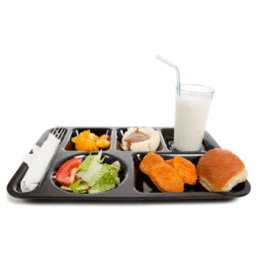
After the First Lady transformed the nation’s lunches for kids, we were curious if our local schools were rising to the call, offering healthy foods and a unique, nutritious approach. Indeed, it does appear each lunch tray is one small step toward a healthier South Jersey.
A clamor of little voices echoes off the walls as students at Joyce Kilmer Elementary School line up, piling their lunch trays with orange slices, green beans and whole-wheat rotini and meatballs. Some of them still pink-cheeked from recess, the lunchtime crowd makes their way along a miniature salad bar, grabbing fresh carrots, cucumbers or boxed salads. One girl skips back to her table with a shiny red apple held high above her head.
Something is different here. In the middle of the cafeteria, John Hayden —that’s Farmer John, to the kids—holds up a fresh bell pepper, plucked from a nearby cart that’s laden with apples, berries and squash. “I want to talk to you guys about fruits and veggies!”
Hayden, a representative from J. Ambrogi Foods Distribution, visits Cherry Hill elementary schools six times a year during lunch services, introducing students to the many Jersey Fresh fruits and vegetables grown, harvested and served locally. It’s a program called Farm to School and the kids love it, administrators say.
That’s clear to see from the energetic room: Hayden entertains and informs, asking the kids about their favorite Garden State-grown foods (shouts could be heard for corn, green apples and broccoli) and trivia questions, like which fruit is most widely used in the world (strawberries, apparently).
Aramark, the district’s food service provider, partners with West Deptford-based J. Ambrogi Foods for most of its fresh, seasonal produce in school lunches, sourcing everything from salads to pizza toppings, while connecting students to local South Jersey farms. It’s part of a broader change that’s transforming school lunches into meals you actually want to eat, and creating a path to healthy, conscientious consumption early on in life, explains Eric Colebaugh, general manager for Aramark in Cherry Hill.
New approach
First Lady Michelle Obama has championed improvement of children’s health and wellness, as evidenced by the junk-food-eradicating Healthy, Hunger-Free Kids Act of 2010 she helped create. That year brought sweeping changes to school lunches in the first update to USDA guidelines in 15 years.
This school year, additional USDA rules were activated that require adequate servings of fruits, vegetables, whole grains and proteins each day. The changes encourage greater consumption of a variety of colorful fruits and vegetables, adhering to calorie and nutrient guidelines that are appropriate for student age groups—far different from years past.
Another schoolhouse staple adults might miss: the food pyramid, now replaced with a visual called MyPlate. Instead of confusing stacks representing servings of bread or dairy, now you’re instructed on what types of food to eat for each meal, using segments of an actual plate: half the plate for fruits and vegetables, quarters for protein and grains, with dairy on the side. Simple enough, even for elementary school children.
In practice
Washington Township schools have adopted the tough new federal standards by introducing new vegetables; revamping taco shells, hoagie rolls and breadings with whole grain flours; and swapping deep-fried items for baked french fries.
“[We are] ensuring that meals are healthier, well-balanced and provide students all the nutrition they need to succeed at school,” boasts the district.
Tara Schrumpf, a senior at Washington Township High School, buys lunch now and again as she sits at a table with her friends. She has noticed a positive change in the lunchtime fare, though she’s still not entirely convinced.
Of the good, she ticks off a list: “They sell apple slices now, salads almost every day, don’t sell soda anymore, baked chips now instead of fried.
“I think in general people do care [about eating healthier]. They do try to get salad and fruit, though guys get pizza and pretzels” more often than not, she says. The intramural soccer and basketball player says she’d be swayed to enjoy the WTHS cafeteria more frequently if it offered more creative meals, like a build-your-own salad bar or sushi.
“I think a lot of people would buy lunch if there was something like that. I’d eat if I knew it was fresh and everything,” she says.
Dan Norris, a junior at Paul VI, has no complaints about the food he’s eating: On his tray you’re likely to find whole-grain breaded popcorn chicken or a fresh-made deli sandwich with fruit, plus a bottle of water or iced tea on the side.
Chartwells dining service, which handles the Paul VI kitchens, splits its menu into sections like “Trattoria” for Italian-inspired hot entrees or “Healthy Highlight” for lighter fare like vegetable risotto. On any day, you’re likely to encounter a fajita bar, chicken Caesar salad wraps, or soup du jour from Au Bon Pain.
“This year, we had a big change” from the traditional pizza and hamburgers, he says. “They eliminated all sodas, so now it’s just water and juices ... vending machines got rid of chips and salty stuff. They added a deli section that’s sort of like Subway, with all different kinds of meats and toppings ... and a big salad bar.”
Though Norris isn’t naturally a fan of salads, he’s pleased with how the school has been shaping up. “They really have a great lunch so I can’t complain: I get it every day,” he says.
Model students
As other districts improve with their own approach to lunch, the Cherry Hill district can perhaps be seen as a model, demonstrating a creative approach that helped earn a Bronze award level in the federal HealthierUS School Challenge. Gone are the mystery meats and bland TV-dinner-like foods; now at Cherry Hill West, the brightly colored cafeteria has a smoothie bar, made-to-order wraps, and whole-wheat grains taking up far more than half the menu. Every check-out line is designed with visible displays of fresh fruit and baked (not fried) potato chips and snacks to complement students’ meals.
The schools have had greater success by bringing in a professional food service provider, says Amamark’s Colebaugh. That’s enabled schools to rigorously adhere to nutritional standards, while the “educators can focus on educating,” he says. The result of this partnership has been a food service program that’s gone above and beyond the national guidelines, establishing a “highly engaged” program from elementary levels on up.
Cherry Hill West senior Kyle Sullender buys lunch every day and is a member of the school’s growing Wellness Committee. In the once-a-month meetings, parents, school nurses, administrators and students discuss concerns and changes, and brainstorm future menu improvements.
A typical teenager, Sullender’s plate is normally filled with a la carte options, whole grain pizza or a buffalo chicken wrap. “I try not to overdo it, but even if I don’t get the healthiest of options, I know it’s always going to be something better for me,” he explains. Though policies may continue to change as schools put them in practice, it’s clear South Jersey’s cafeterias are already making positive strides, balancing out what kids like to eat with what they need to succeed.
Published (and copyrighted) in South Jersey Magazine, Volume 10, Issue 1 (April, 2013).
For more info on South Jersey Magazine, click here.
To subscribe to South Jersey Magazine, click here.
To advertise in South Jersey Magazine, click here.











